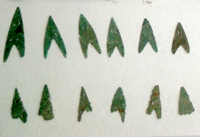 |
The Greek Age of Bronze
Arrows/Bows |
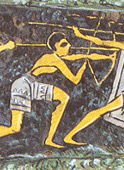 |
| The bow is one of the earliest known weapons of war and because of its range it was also the most convenient weapon of the hunter. The usage of the simple wooden bows and arrow shafts are attested in Europe since the late Upper Palaeolithic period (before 10550 BC).In Greece the bow is likely to be acknowledged as an autochthonous weapon since the Neolithic period, even though in the Minoan and Mycenaean world it never equalled the importance and diffusion that bows generally had in oriental societies. From the Aegean Bronze Age period two main types of bow are known: the simple wooden bow sometimes reinforced with sinew glued to the back to prevent breakage and to increase the bow's cast; and the composite bow which combines four material -wood, sections of animal horn, animal tendons and sinews, and glue. Even the wood was sometimes not made from a single block but comprised pieces of wood from different trees with varying pliability. Both the simple and composite bows can be divided in diferent types based on their shape: the simple curved bow (fig. a,b); the double-convex bow (fig. c,d); the double-concave bow (fig. e); the triangular bow (fig. f,g) largely used in the Near East and Egypt. Some other type of bows are also identified with the name of the population who invented them, like for instance the Scythian bow (fig. h) also used in Greek during the archaic and classical/Hellenistic periods. |
 |
| None of the improvements to give the bow greater range would have been of any value without comparable advances in the development of the arrow, which is the offensive element of this weapon. The arrow is made up of three parts, each of a different material to suit its special function. The arrowhead had to be of the hardest possible material-Flint, bone, or metal. The body of the arrow which had to be long, thin, hard, straight, and light, and was made of wood or reed. The tail, designed to keep the arrow on its course in smooth and straight flight, was made of feathers. |
| One of the early evidences of bow in the Aegean area is attested in this seal with hieroglyphes engraving from Mallia Crete dated around 2500 BC, where a double-convex bow and relevant arrow are well represented. |
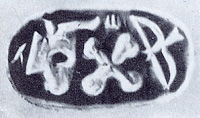 |
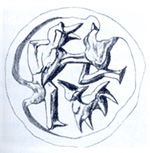 |
An hunter armed with a simple curved bow and his dog are depicted in this seal from Crete dated around 2200 BC. |
| From the same period are these other seals from Mallia Crete where human figure armed with simple curved bow are depicted. |
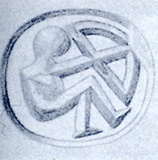 |
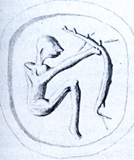 |
| Cretan archer represented on seal dated about MMI The flat representation of the arrow-head was probably because it was secured by bitumen as for the example from a chisel-edge Egyptian arrow-head. |
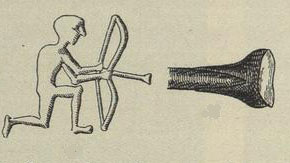 |
 |
A probable composite double-convex bow is also one of the simbols of the still undeciphered disk from Phaistos dated 2000-1700 BC. This type of bow seems to be different from the ones depicted in the contemporary Aegean art so it could be a representation of a Near East composite bow. |
| This other "glove like" simbol of the Phaistos's disk has been interpreted by some scholars as a possible protective device used by bowmen (*1) . |
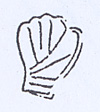 |
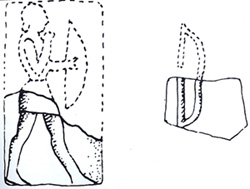 |
In the scenes of the " mosaic of the cities" from Knossos dated around 1700 BC several armed figure are depicted. some of these warriors have been interpreted as armed with bow and simple or double-convex bows are also represented. |
| On a seal from Hagia Triada Crete dated around MM IIIB-LM I (around 1600-1500 BC) a male figure or a deity with a composite double-concave bow is depicted. |
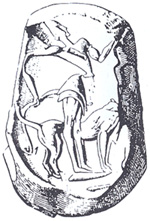 |
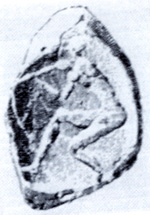 |
In another seal always from Hagia Triada dated around LM I/IB (around 1550-1500 BC) a bowman armed with a simple curved bow is shown. |
| An archer in the same partally kneeling position with a simple curved bow is also represented in this relief from Phaistos Crete dated XVI century BC. This bow man seems to wear a protective corselet made of thick stripes of cloth and short trousers. |
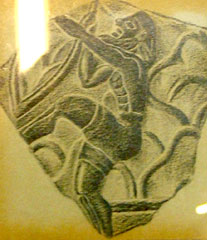 |
 |
In the Greece mainland a simple curved bow is well represented on the central rib of the famous "Lion Hunt" dagger from the shaft-grave IV in Mycenae dated from LH I to LH II (about 1550-1500 BC). |
| Another interesting representation of a long simple curved bow (*2) is on the hunting scene of the gold ring also found in the shaft-grave IV in Mycenae. This representation attested that the Achaeans also utilized the chariot as archery platform since the XVI century BC.
|
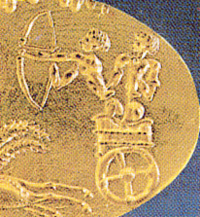 |
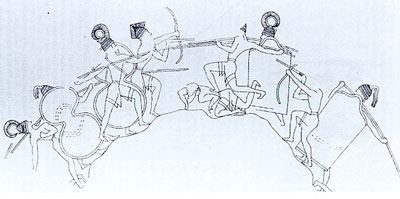 |
Coming from the same shaft-grave IV this silver "rhyton" shows a beautiful battle scene where two warriors are equipped with double-convex bows . |
| In another battle scene on the silver "rhyton" also from Mycenae shaft-grave IV three bows are visible. Two of these are clearly simple curved bow, while the first one on the left seems more likely a double-convex bow. |
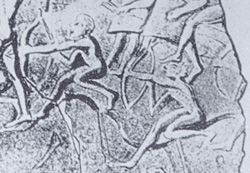 |
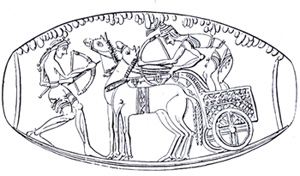 |
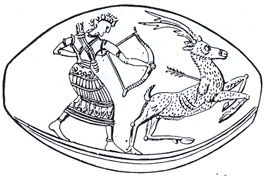 |
Two simple curved bows reinforced with sinew in the center and in the ends are shown in these questionable seals from Thisbe Boeotia dated LH II (about 1500 BC) (*3). In the second seal the quiver and the arrows are also represented beared on the back by the presumable hunting deity. |
| In this interesting pendant from Crete dated around 1500 BC a figure with an elaborate long "all around wrapped" tunic is depicted. Behind the figure the end part of a presumable double-concave bow is also visible. |
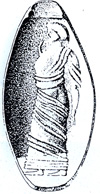 |
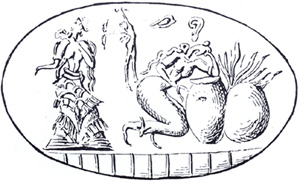 |
In this gold ring more likely from Vaphiò dated about 1500-1450 BC, the small figure between the two women is more likely bearing a double-concave bow. |
| In this other seal from Crete dated around LM II (about 1500 BC) a female figure with a double-convex bow is depicted. A possible quiver is probably represented along the waist of the woman. |
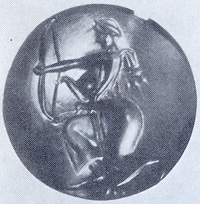 |
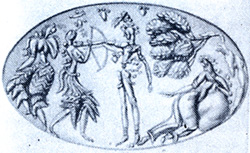 |
A simple curved bow is also represented in this gold ring of unknown origin dated about 1500-1450 BC. |
| A double-convex bow and an arrow are well represented in this seal from Crete date around 1400 BC. A possible archer's head long haired and bearded with large round ear-ring is also represented. |
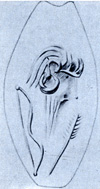 |
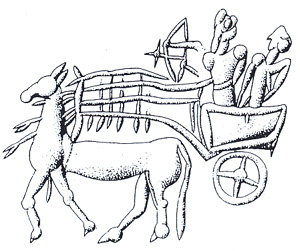 |
A warrior on chariot with a simple curved bow is represented in this hunting scene on a seal from Cyprus dated XV-XIV century BC. The arrow's head with a strange shape is represented with three points. This is another clearly evidence of the chariot utilized as archery platform. |
| A very long simple curved composite bow seems represented in this seal from Rhodes date around XIV century BC. Also in this case, even if the scene is related to hunting activity, the seal demostrates the use of the chariot as achery platform also in the Aegean areas. |
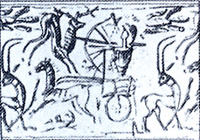 |
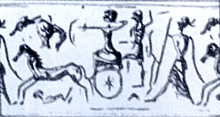 |
A simple curved bow is also represented In this other hunting scene on a small seal from Enkomi Cyprus dated around XIV century BC. |
| In these two seals respectively from Dendra and Mycenae dated LH IIIA (about 1370 BC) composite double-convex bows are more likely represented. The general shape of these bows is similar to the bow simbol present on the above mentioned disk from Phaistos. |
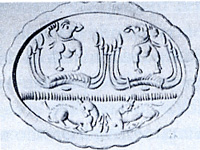 |
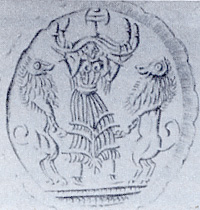 |
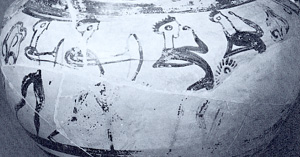 |
Two Men, probably involved in athletic games, armed with simple curved bows are represented In this pottery from Enkomi Cyprus dated around 1300 BC. |
| Some warriors represented in the fresco of the "Megaron" from Mycenae dated between LH IIIA and LH IIIB (1370-1350 BC) have been interpretaed as armed with bow. Of course this reconstruction as well as the complete battle scene with warriors armed with spears and bows, charioteers, horse men etc..is only hypothetical and fully questionable being the few survived parts of the fresco very fragmentary. |
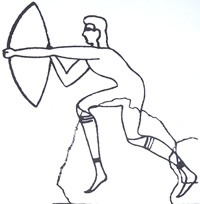 |
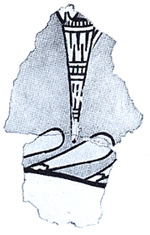 |
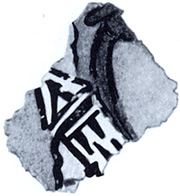 |
Very few archaeological elements can suggest the presence of quivers like for instance the ivory or metal elements found in some Achaean graves (*4) or as attested in the "hunter grave" from Zapher Papoura near Knossos, the presence of a mass of arrow points located in an upper level respect to the grave floor could be a possible evidence that the arrows were placed inside a quiver which was hunged on a dedicated area of the grave . From what concer the figurative art these two elements depicted on fresco fragments from Tiryns dated XIII century BC are more likely representation of quivers. These objects were clearly painted or decorated and the one on the right seems equipped with a cover. The presence of a cover is in fact also attested in the Homeric description of the quivers (*5) |
| Two quivers are more likely also represented in one side of this bronze axe from Voros Crete dated around LM III. Also in this case the quiver are represented with a decorative motif a cover and the strap. |
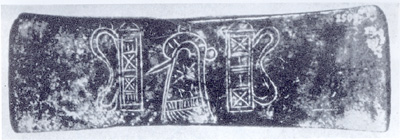 |
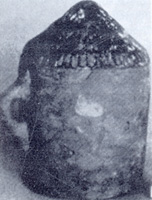 |
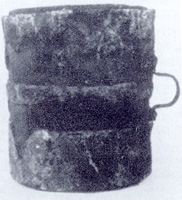 |
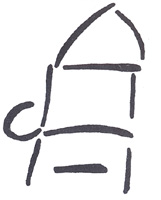 |
Very interesting it is the general shape of these bronze cups from Thera and Dendra and the linear B simbol *123 from Knossos also related to a vessel. It is evident the similitude between the shape of these object and the figurative immages of the above shown quivers. |
| A quiver seems also hanging from the side of the chariot impressed on this pithos fragment from Analiondas-Pareklisha Cyprus dated around 1300 BC. The representation consists of a hunting scene and both the chariot (except for the four-spoke wheels) and the hunter may recall Egyptian representations (*6) even if the rest is of Aegean inspiration. |
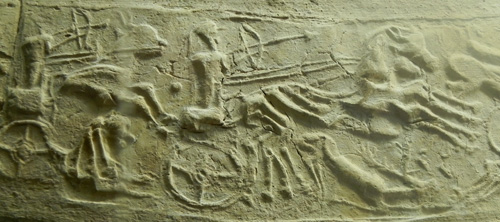 |
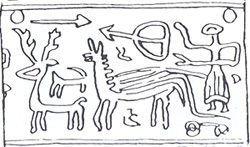 |
A Simple curved bow with the arrow are depicted on a seal from Cyprus dated XIII-XII century BC. In this case an hunting scene is represented with the archer hunting from a four-wheeled chariot. |
| An archer armed with a simple curved bow is depicted in this pottery fragment from Iolkos dated around LH IIIC (about 1200 BC). Despite the very schematic representation the warrior seems placed in elevated position behind a structure wich could be interpretaed as a wall or a tower. |
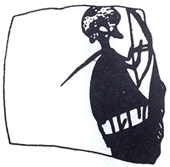 |
What is probably a composite bow is also used by an acher (possible a woman) represented on a fresco fragment from Pylos dated LH IIIC. The upper part of the bow seems to be straight. The bow was depicted in two superimposed paint layers: the first to be applied was a layer in black that followed a red sketch line visible at the outer left edge of the bow; a second layer of thick white paint followed, but it has extensively flaked away.
Rounded brush strokes of white paint in relief, visible along the inside of the bow, were presumably meant to suggest some decorative motif applied.
|
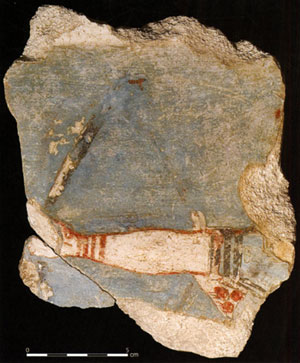 |
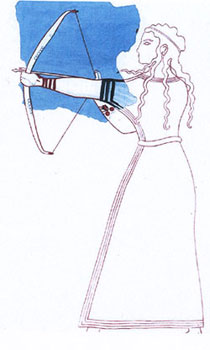 |
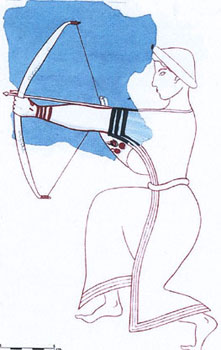 |
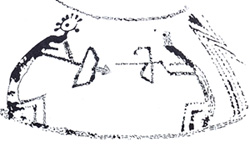 |
Fighting warriors both armed with double-convex bows are represented in this other pottery fragment from Lefkandi dated 1100-1050 BC. This scene reminds the epic duel with bows and arrows between the Trojan prince Paris and the Achaean archer Philoktetes. |
| A very schematic simpled curved bow and relevant arrow are also represented in this krater from Enkomi Cyprus dated about 1100 BC. |
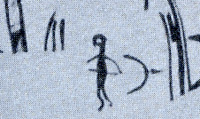 |
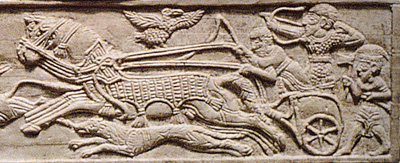 |
In another hunting scene engraved in this ivory gaming box from tomb 58 in Enkomi Cyprus dated around XII century BC a warrior armed with a small composite bow is well represented. |
A simple curved bow seems to be used by one of the warriors represented in a dish from the tomb 58 in Palaepaphos-Skales Cyprus dated around 1000 BC. The dish base is decorated with two warriors which seem to be equipped with short scale cuirass, neck protections, bow, spear and sword. The figures are trying to kill a large two-head snake, in the field are three quadrupeds and a flying bird.
No dubt this represent a mythological theme, recalling the Greek myth of the slaying of the snake of Lerna by Herakles and his companion Iolaos. |
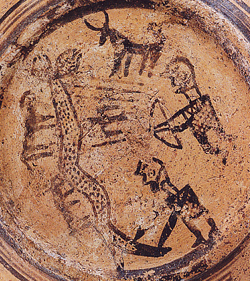 |
| In the Homeric "epos" the bow apparently seems to have a minor importance respect to the other weapons like the spears, the swords and the javelins (*7), indeed its utilization, both by the Trojans and by the Achaeans troops, it is often mentioned. A possible indication of its primary function in a siege war is point out when in the Iliad is told that to conquer Troy would have been necessary to recover the Philoktetes' bow (*8). During his first appearance Paris is described equipped with sword, two javelins and the bow (Iliad III; 15-20). The presence of the bow associated with the javelin is also mentioned when Dolones is moving with his chariot to the Achaean camp (Iliad X, 333-336) even if normally the bow and the javelins or spears are described as alternate weaponry of the warriors' equipment and not complementary (Iliad VII, 136-141; XI, 191; XIII, 311). A strange utilization of the bow is attested when Odysseus use this weapons as a whip for the chariot's horses (Iliad X, 500 and 513-515). A detail about the manner to use the bow is given when Pandarus pulled the string of his bow up to his chest (*9). In the Iliad the presence of the bow is also associated with some defensive weaponry well attested in the Achaean archaeological fonts like for instance the full body shield of Ajax (Iliad VIII, 266-274) or the boar tusked helmet of Odysseus (Iliad X, 255-265). Some important indications about the tradition of this weapons in the Achaean society is present both in the Iliad and in the Odyssey. In fact the bow is often given as a gift sometimes transmitted from father to son for several generations: the bow of Philoktetes is the one of Erakles, the bow of Pandarus and Teucros is a gift from Apollo (Iliad, II, 824-827; XV 441); the bow of Odysseus is a gift of the famous archer Iphitos who get the bow from his father Euritos (Odyssey XXI, 11-41). These bows, symbols of an ancient tradition, are hanged with a nail in the palaces' walls almost as objects of cult (Iliad V, 209; Odyssey XXI, 53). This element remind the sacral gifts in the temples in which also bows, belonged to famous Homeric heroes, are in later myth mentioned (*10).
If this elements attested as the bow was an important element of the Achaeans weaponry its consideration as "heroic" weapon is sometime controversial. Agamemnon for instance promises to Teucros the honour of the second place in the division of the booty of Troy because he is very smart to kill the enemy using his bow (Iliad VII, 266-334), thus he qualify the archer as one of the most valiant warrior between the Achaean warlords. On the contrary Diomedes is very contemptuously respect to Paris and the bow-men in general, showing his bad consideration about the use of the bow and the distance fighting techniques (Iliad XI, 385-395). In the Iliad the bow if often associated and used by the mass of light armed warriors like for instance the army of Philoktetes (Iliad II, 716-720) or the Locrians leaded by Ajax Oileus. On the Trojan side the bow is used by the Carians and the Lycians, furthermore both the Achaeans and the Trojans are often described using the bow and the arrows together other throwing weapons (Iliad III, 7980; VIII, 510-516; XV, 312-319; XVI, 316 and 772-774). The images of group of light armed warriors without defensive weaponry (Iliad XV, 471-473; Odyssey XXII, 116-125) equipped with bows and slings is also attested in some archaelogical fonts as for instance in the battle scene on the silver "rhyton" from Mycenae. Another comparison between the images coming from some Achaean artistic representation and the Iliad bow-men tactics description can be made with the description of the archers hide behind the huge shields of the other warriors like for instance Teucros and Ajax (Iliad VII, 266-334) or Pandarus protected by the shield of his friends (*11). The bow-men are not fighting in advanced position but they throw the arrows far away and behind the first lines (*12). The bow is thus used at the beginning of the battle before to start the men to men fighting (Iliad XV, 312-314). In some epic representation the bow is also the weapon of the special missions, of the ambushes, of the revenge and the challenges as for instance in the mission of Doloes described in the book X of the Iliad, the Odysseus expedition to Circes (Odyssey X, 261-263), or the Pandarus' arrow which hit Menelaus breaking the truce. The bow is also the preferred weapon of Paris and his arrow was the cause of the premature death of Achilleus. This weapon is often associated with Odysseus the most clever of the Achaeans heroes. He used his bow to get his revenge against the suitors (Odyssey XXI, 57-268). |
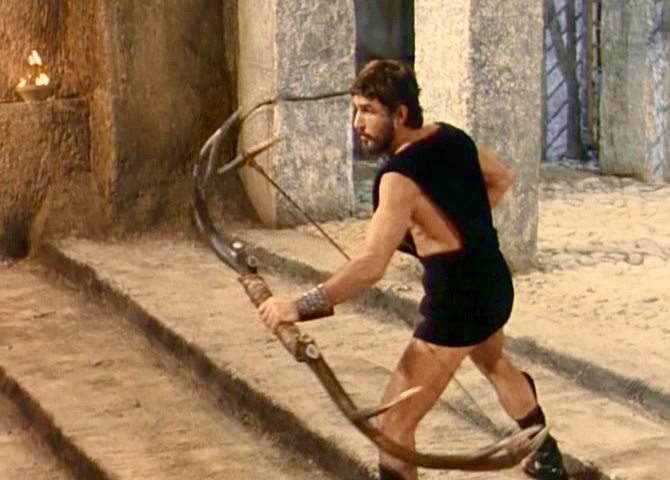 |
For what concern the possible reconstruction and the type of the bows described in the Homeric poems it is worthy to be mentioned this interesting analysis and hypothesis made by Giovanni Amatuccio.
From the few indications of Homeric texts, emerges a sure date: the Odysseus and Pandarus' bows were made of horn. In fact Odysseus, before to use the bow, checked it accurately to verify if it had been pick by the ipeis (wood-worms of horn) (*13). In the Iliad it is better described the composition of Pandarus' bow: compound by horns of "jumping goat" (aigos agriou)...16 palms long (ekkaidekadora) assembled and smoothed by an "horn polisher artisan" (keraokos erare tekton), who finished it adding two golden tiops (chruseen...koronen) (Iliad IV, 105-111).
No doubts about the materials used for the bows described by Homer, but the problem remains how to intend more details in such data. This subject has divided the early and modern scholars in two different groups.
The most numerous and reliable of them, has supported the thesis that the Homeric bows must be interpreted like "composite bows" of oriental type, where horn was only one of components, joint with animal tendons and wood.The first was Luschan, who denied that the composition of the Homeric bows should be intend, sic et simpliciter, as union of two horns. He demonstrated that such bow would be uselessy strong and impossible to draw without some mechanism help (indulging their calculations this bow would have expected a drawing weight of 500-1000 Kg). He help up, therefore, thesis of the doppelbogen (reinforced bow), on Oriental model.
Reichel empower such thesis through a different version of Homeric texts. In fact, he intended words referred to junction of the goat horns, instead that-how happened in precedence- "the horns jointed between them",as "he jointed the horns to the bow", interpreting, therefoe, the sense of verses, as referred to application of horn layers at a skeleton constituting the bow.
Allowing the Bulanda reading, the bows described by Homer were assembled with joining of the two horns by a rigid support wood. the arguments produced for maintenance of its thesis were principally the folowwing: Homer indicated the rodents of Odysseus bow as rodents of horn (ipeis) and not as simply wood-worms; the artisan that assembled Pandarus' bow was a horn carver and not a carpenter; a bow of the kind hypothesized, was findable in some Egyptian manufacts of First Dynasty found in Abydos, formed by two Oryx horns both jointed with a piece of rounded wood.
We can underline some elements which without doubts do us to lean for "composite thesis". First of all, the fact that the Poet does not describe the others bow components-indicating it only like as horn bow- goes interpreted on the base of Arabic and Turkish construction techniques (to remain on most documented ones). Here the wood is considered as simply support, upon which tendons and horn were glued. In fact, the wooden part was constituted by a thin layer, that itrepresent, in the best hypothesis, 1/3 of total material. Such relationship was lesser in flight-bows or war-bows, where horn occupied a preponderant part respect to the others materials, and from it depended the bow force.
Therefore, it appears plausible that Odysseus' bow -so strong that only he was able to armed them-it were constituted by a preponderance of horn. At such purpose it goes also remembered that in Italian Middle Age, composite bow was pointed commonly as "Arcu de corno" (bow of horn) to distinguish it from that simple of only wood.
One other analogy with the composite bows can be checked in the episode which describes Antinoo's attempt to bracing bow with fire help (Odyssey XXI, 176-180). Well, also flight Turkish bows (as above remembered, composed prevalently of horn) expected an hot conditioning to be braced. But we come now the bow typology, so as described in Homeric poems: typology which it seems confirming, staying to shape and dimensions, the "composite thesis". First, type of worn-out horn is indicated explicity to be agrimi horn, term that would identify wild goat (Capra Aegracus), very common in early times at Cretes and in others Aegean islands. The horns of such animal were much longer than those of common goat, and in our case is specified that they "grew 16 palms". Palm goes here intended not like to measure of open hand-from thumb tip at the little finger- but like real hand palm broadness.It would correspond therefore to the common Greek measure PALAISTE, which it counts about 7.5 cm. The two horns, therefore, measured togethere about 120 cm: sufficient length to compose the two limbs. Pandarus' bow, so assembled, was refined with golden tips (korone) used to link the string. Habit to use precious metal tips is remembered also by Ascham in the Toxophilus, who however, discourages it, retaining more proper horn or bone tips. The shape remains the harder thing to establish. From indications of Homeric text we can only take over references, offered in more points, to the strong reflex curve, expressed with term palintonon, that it comes used in place of the commonest kampylos, that it indicated the simple bow curvature.
|
| A very usefull diagram of the development of Aegean arrowheads has been published by Nicolas Grguric on his book The Mycenaeans c. 1650-1100 BC published by OSPREY IN 2005. The drawing is from Professor Dr H-G. Buchholz. |
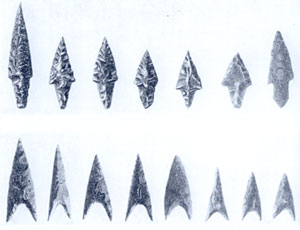 |
A large quantity of flint and obsidian arrowheads are attested in the Aegean area since the Neolithic period. Mostly of these arrowheads have been found in the Thessaly settlements and in other areas of the north part of the Greece. Even if during the later periods 2500-1500 BC these early model of arrowsheads were still used in severeal areas of the Greek mainland and in Crete. Furthermore these early type of arrowsheads show similarity with specimens coming from the Balcans and central area of Europe up to the south lands of Russia. |
| The flint and obsidian arrowheads with the typical "heart" shape are attested since the LH I and LM I (about 1550 BC) both in Crete, Cycladic areas and in Greek mainland. These "heart"shaped type derived as an improvement from the early arrowsheads in the shape of a thickset triangle with the short tailcoat.
|
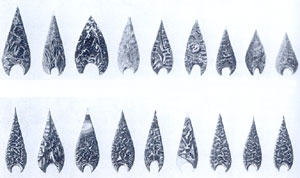 |
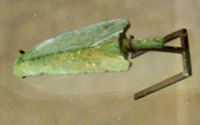 |
A quite big bronze arrowhead from the Cycladic island of Amorgos dated around 2300 BC |
| These obsidian arrowheads "heart" and "thickset triangle" shaped come from different areas of Crete and can be dated around the XVI century BC. Unfortunately, arrowheads cannot be used to form a chronological typology on the basis of their form, in the way that pottery, for example, often can. Historical and ethnographic evidence has shown thta it was usual for archers to carry several different types of arrows in their quivers at once to be used for different targets range and typology. |
| Obsidian arrowheads "heart" shaped are well attested also in Greek mainland. Several of these arrowheads have been found by Schliemann in the shaft tombs of Mycenae. These ones are the fifteen different types found in Sepulchre IV dated around 1550-1500 BC
|
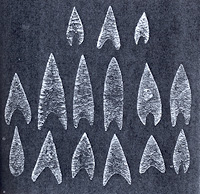 |
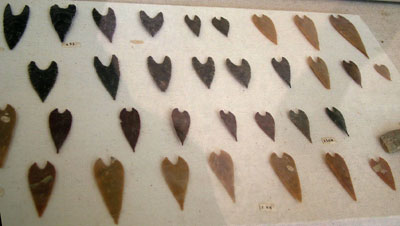 |
Obsidian arrowheads "heart" shaped are well attested also in Pylos and in the surrounding areas both in the palace rooms and in the burials. The flint and obsidiane continued to be used for arrowheads even when the use of bronze was widespread. For this reason it is also unconvincing to create a chronology on the basis of what arrows were made of. The only remaining means of determining the relative age of arrowheads is through stratigraphic dating (the soil level in which the artefact was found), unfortunately such records are often incomplete. |
| As well attested from these bronze arrowheads from Pylos dated around LH IIIA (around 1370 BC) there is also continuity in some of the shape between the arrowheads made of obsidian and the ones made of bronze. The large V-shaped arrowhead is one of the earliest types as well as the longest-used. This type was used from about 2000 BC right down to the end of the Mycenaean period. |
 |
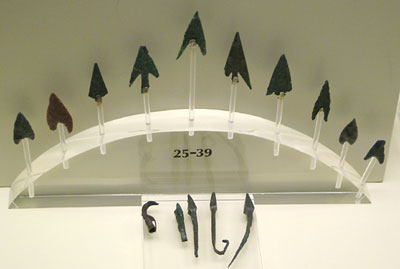 |
Bronze and obsidian arrowheads coming from the same period are attested in mostly of the Achaean settlements in all the Greek mainland and Crete. The most important area where a large ammount of arrowheads have been found both in the palace and in warrior shaft-graves and tholos are: Pylos, Mycenae, Dendra, Tiryns, Athens, Thebes, Gouvalari, Nichoria-Malthì, Tragana, Kakovatos, Volymidia, Prosymna, Asine, Kephalovrysso, Makryssia, Peristeria, Spata, Thorikòs, Dimini; and in the island: Knossos, Phaistos, Sanatorium in Crete, Phylakopi in Melos, Ialysos in Rhodes, Thermì in Lesbos, Enkomi, Hagia Anastasia, Lapithos, Hagios Iakovos in Cyprus. Late Achaean arrowheads have been also found during the exavation in Troy VIh, VIi strata. |
| Bronze V-shaped arrowheads from Knossos dated around 1500 BC. This type of arrowhead was the easiest to produce in large numbers, and thus the most suitable for large scale issue to soldiers. |
 |
| Bronze V-shaped arrowheads with tang also coming from Knossos dated around 1500 BC. The metal variant of the tanged and recessed-based arrowheads were simply cut out of bronze plate. |
 |
| Bronze cast arrowheads in shape of elongate triangle with pigtail from the graves in Sanatorium Crete also dated around 1500 BC. Unlike the simple V-shaped arrowheads this one had to be cast in special moulds.
|
 |
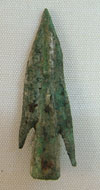 |
Bronze cast arrowhead with socket from Phaistos Crete. These type of arrowheads seems to have been significantly less numerous than the V-shaped variety, perhaps for economic reason. Some scholars belived that this and the other cast arrowheads have probably oriental origins, even if more likely manufactured in the Aegaen area. |
Bronze V-shaped and cast arrowhead in different shape from Achaean settlements dated from 1500 BC to the final phases of the Mycenaean period. For what concern the largest points it is sometimes difficult to determinate their correct identification and these may be light javelin heads as well (see Group M in the page dedicated to the spears and javelins).
As attested in the Achaean pictorial art and in the Homeric poems the arrows were used both for hunting and war. The same evidences show as the bow-men used their weapons on foot and from the chariot. Based on the archaeological fonts or Linear B descriptions there are so far no evidence that poisoned arrows were used by the Achaeans warrioros. Indded a reference of poison arrows is also mentioned by Homer (Odyssey I, 260-264); so this possibility, at least for some of the most skilled Achaeans or Trojan archers can't be excluded (*14).
|
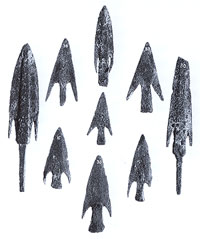 |
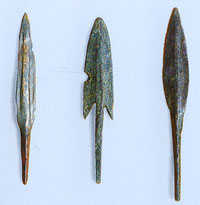 |
A large quantity of bronze arrowheads are also been found in several settlements in Cyprus. Mostly of the arrowheads are the cast typology with pigtail like these ones from Maa-Palaeokastro dated around 1200 BC. The length of these points from left to right is 10 cm, 9.7 cm and 11 cm. |
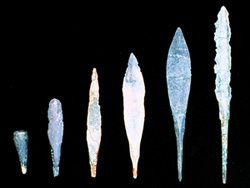 |
Similar shaped arrowheads of different sizes have been found in the shipwreck excavation at Uluburun near Kas in the southern Turkey coast .Blunt example on left was for use in fowling . In this cargo ship dated about 1300 BC several Canaanite, Cypriote and Achaean manufactured goods have been found as well as raw material, weaponry and ceramics. |
| Some Achaeans bronze flat arrow plates have been also found during the various excavations in Troy. These one are from the Troy VIh and VIi strata where signs of fires, destruction and war seem to be also attested.
|
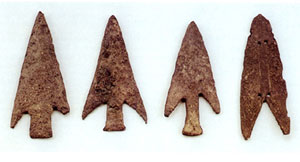 |
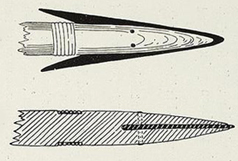 |
Suggested method of flat arrow plates inserted in hardened wood points.
|
For what concern the artistic representations the arrows are present in several seals showing animals like lions, bulls, goats hit by arrows. These seals have been found in several Achaean settlements in Greece and Crete dated from XVI to XIII century BC.
Further informatons about the characteristic of the arrows can be taken from some Homeric descriptions, Menelaos was hit by the Pandaros's arrow (Iliad IV, 151) but its point remained in surface because the "sinews" and the "hooks" did not penetrated into the flesh. This attested that the arrows'point was fixed to the shaft by means of strings or animal fibers. In another Iliad book (Iliad XI, 584) the arrow's shaft made of straw (*15) is mentioned, this shaft breaks when the arrow hits the target. In two Iliad's books there is also an adjective (*16) which could be related to the three tips of the arrow's point (Iliad V, 393 and XI, 507)
|
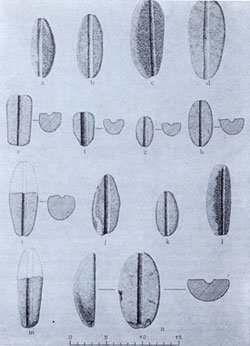 |
A very interesting object attested in the Aegean Age of Bronze and related with the arrows is the "smoothing tool" for the arrows' shaft. This tool was composed of two equal elements made of flint with an oval shape flat in one side and curved in the other side (like a big egg longitudinally cut). In the flat parts a groove with the diameter of the arrow's shaft was present. The longitudinal movement of the two element joint together was used to smooth the wood shaft of the arrow placed in the groove. |
| BOWS AND ARROWS IN LINEAR B
|
| Even if so far no clearly indication of bows have been found on Linear B tablets, these two simbols respectively on tablets from Pylos (*249) and Knossos (*256) have been interpreted by some scholars as the possible representation of a simple curved bow. |
 |
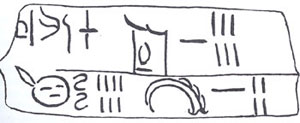 |
In this other tablet from Knossos the ideogram *151 (in the middle of the lower line) clearly represents the horn of the Cretan wild goat (Capra Aegracus). this simbol associated with the other three ideograms have been interpreted as the row materials used for the bows construction . |
| The ideogram *231 on the Linear B tablet R 4482 from the Knossos palace's "arsenal" is more likely the representation of the arrows. This simbol was followed by numbers which probably indicated the quantity of the objects. |
 |
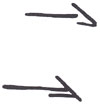 |
A little bit difficult is the identification of the simbol *254 on the tablets Ws (1704, 1705, 8495) from Knossos. This simbols has been both interpreted as arrow and javeling, even if in the same area several containers with arrows have been found. The simbol is also associated with the word pa-ta-ja which seems a generic term to indicate the "throwing weapon". This simbol may only indicate the arrows or Javeling's points while the above mentioned *231 may represent the arrow's shaft (*17).For what concern the arrow there are also two indirect references in the Pylos tablets PY Jn 845 qe-re-me-ne-u and PY Jn 320 with the word e-ki-wo.
|
In the tablet An 207 (+) 360 from Pylos a list of peoples working in the palace are mentioned. Between them there were also five "bow manufacturers" to-ko-so-wo-ko (*18). It is not specified if these bows were utilized for hunting or warfare but the large numeric indication of the arrows (6010 and 2630) in the tablet KN R 4482 is a clearly indication that the palace adminstration took care of the production, storage ad distribution of the arrows. Such large quantity of arrows storaged in the palace justify their utilization as war armament, being the hunting equipments more likely keeped by the single hunters.
An important reference about the military use of the bow is present in the Linear B tablet KN V 150 (+) 7624 from Knossos where the words to-ko-so-ta a-te-u-ke (*19) can be interpreted as "unarmed archer" (*20). |
| CONCLUSION
|
The Archaeological evidences attested as the bow was largely utilized in the Aegean area since the Neolithic period. The bow was more likely an autochthonous weapon in the Greek prehistoric time even if some elements suggest the hypothesis of a Central and North Europe influence also attested in some type of flint arrow points. Indeed in the Aegean islands later evidences show connection with some type of Near Eastern bows as well. The simple and composite bow were both used in the Aegean area in the various shape of simple curved, double-convex and double-concave.
Based on the large amount of arrows found in the early Achaean graves as well as on the artistic representations we can assert that the archery was well known since the early period of the Mycenaean civilization both for hunting and warfare. As also attested in the Achaean artistic representations the bow was used both by infantry warriors and charioteers even if in the war tactics of the later period the archers were normally fighting on foot at the beginning of the action and behind the warriors of the first line. Based on some other artistic representation from the early Achaean period, but also attested in the Iliad, single skilled archers were also fighting in conjunction with other warriors both protected by the huge 8 and tower shaped full body shields or by the large round shields. In the Linear B tablets is well attested as the palace system provided the manufacturing, the storage and the large distribution of the arrows. The large diffusion of the bow in the Achaean society is also attested by the presence in the palace organisation of artisans specialized in the bows construction. |
(*1)Evidences of archers' arm protective devices are well attested in some Near east representations even if no similar equipments are so far clearly represented in the Minoan and Achaean art.
|
(*2)Based on the artistic representation the simple Achaean bow was more likely about 1 meter to about 1.5 meter long.
|
(*3)Even if the autenticity of the seal-stones from the Thisbe "treasure of seals" is actually questionable their iconographic model are significative being more likely based on real speciments.
|
(*4)Some ivory, gold and bronze elemets found in several Achaean graves can be interpreted as decorative parts of quivers as for instance an ivory plaque with spirals from the grave III of Hagios Ioannis or some of the gold elements from from the Shaft grave IV, V and VI from Mycenae being several arrow points found in the same context.
|
(*6) Evidence that in the Aegean areas the javelin and the spear were the preferred weapons to be used from the chariot it is also attested in the Iliad when for instance Pandarus, disappointed about the effectiveness of his bow, decided to fight against Diomedes from the chariot using the spear instead of the bow. (Iliad V, 230-238).
On the contrary in the Near East the bow was instead the preferred weapon to be used from the chariot as well attested in several pictorial immages.
|
| (*10) We know from the later mith that for instance the bow of Heracles was preserved in the temple of Apollo Alaios at Krimissa near Croton, the bow of Pandarus would has been preserved by Teucros in the temple of Athena at Lindos; and the bow of Teucros was offered in the temple of Apollo at Sicione.
|
|